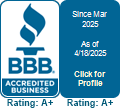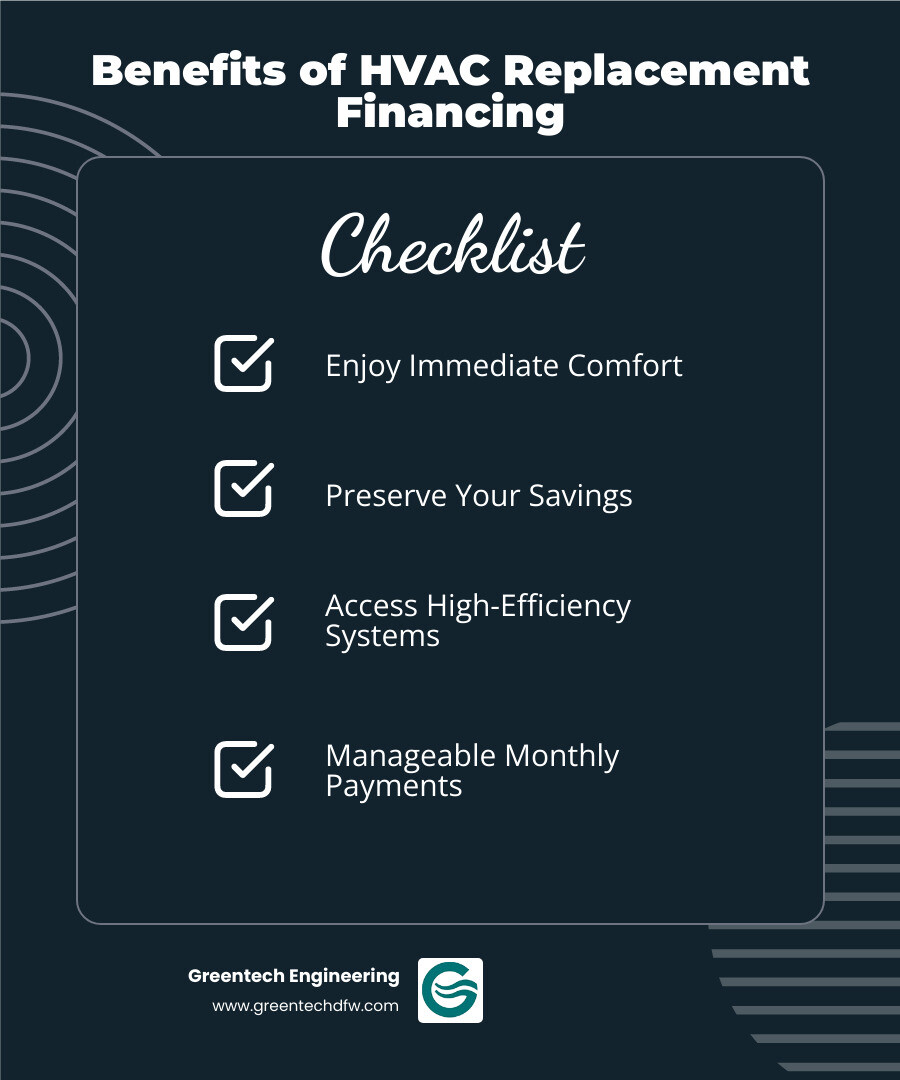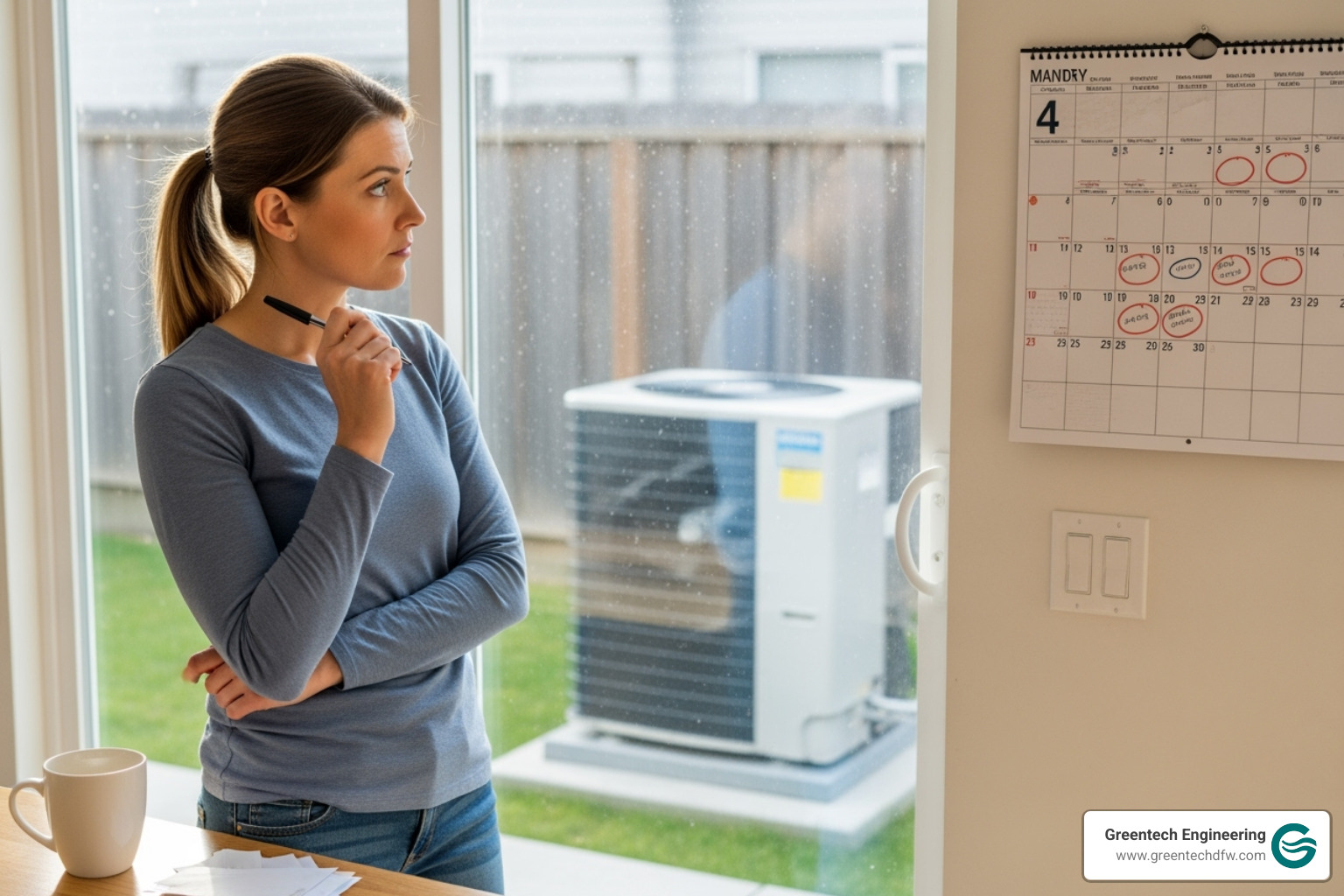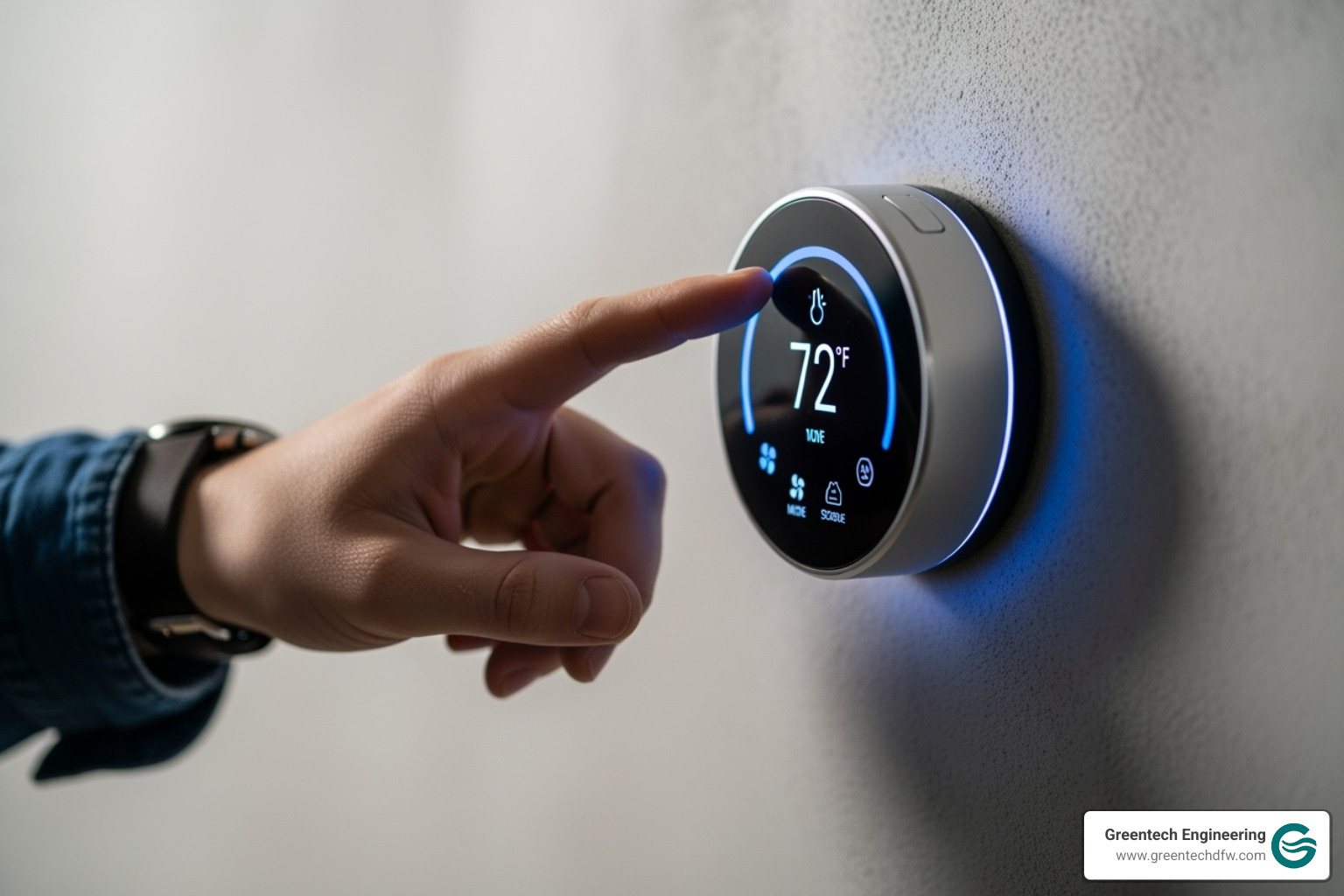Why HVAC Replacement Financing Makes Smart Financial Sense
HVAC replacement financing allows homeowners to spread the cost of a new heating and cooling system over manageable monthly payments instead of paying the full amount upfront. Here are your main financing options:
Key HVAC Financing Options:
- In-House Dealer Financing – Direct financing through your HVAC contractor
- Personal Loans – Unsecured loans from banks, credit unions, or online lenders
- Home Equity Financing – HELOCs or home equity loans using your home’s value
- Rental/Lease Programs – Monthly payments without ownership (read terms carefully)
When your HVAC system fails or becomes inefficient, financing transforms what could be a financial crisis into a manageable home improvement project. Rather than draining your emergency fund or delaying essential comfort, financing lets you invest in your home’s comfort immediately.
Modern financing options also open the door to higher-efficiency systems that might otherwise be out of reach. These advanced systems often pay for themselves through energy savings while providing superior comfort and reliability.
The key is understanding your options. Each financing path has unique benefits – from dealer convenience to bank competitive rates to promotional offers with deferred payments. The right choice depends on your credit profile, budget, and long-term goals.
Decoding Your HVAC Financing Options
When your HVAC system decides to call it quits (usually on the hottest or coldest day of the year, naturally), understanding your HVAC replacement financing options becomes crucial. The good news? You have several pathways to fund your replacement, each with its own personality and benefits.
Think of financing options like different routes to the same destination – your comfortable home. Some routes are faster, others might save you money, and a few offer scenic stops along the way. Let’s explore the main pathways that can get you there.
In-House Dealer Financing
Dealer financing is like having everything under one roof – your HVAC contractor handles both the installation and the financing. Many reputable HVAC companies partner with lenders to offer this streamlined approach, and honestly, it’s pretty convenient.
The biggest advantage here is simplicity. You’re already working with your contractor to pick the perfect system for your home, so adding financing to the mix feels natural. The application process is typically straightforward, often with quick decisions that can have you approved and your system installed in record time.
What makes dealer financing especially appealing are the promotional offers. We’re talking about deals like 0% APR for extended periods or deferred payment plans where you don’t start paying for several months. These promotions can make a high-efficiency system accessible when it might otherwise stretch your budget.
The key is reading the fine print and comparing terms. While convenient, dealer financing isn’t always the cheapest option available. At Greentech Engineering, we believe in transparency, which is why we encourage you to explore all your options. Check out our current Special Offers to see what promotions might work for your situation.
Third-Party Personal Loans
Personal loans from banks, credit unions, or online lenders offer a different kind of flexibility. These are typically unsecured loans, meaning you don’t need to put your home up as collateral – a relief for many homeowners.
The beauty of personal loans lies in their fixed rates and terms. You’ll know exactly what you’re paying each month, making budgeting a breeze. Plus, many lenders offer rate quotes without affecting your credit score, so you can shop around without worry.
Online lenders have particularly shaken up this space, often offering competitive rates and quick funding. The money typically goes directly to you, giving you complete control over your project and contractor choice. This flexibility can be valuable when you want to work with a trusted local expert who prioritizes quality over quick sales pitches.
For a deeper understanding of how personal loans work, this comprehensive guide covers all the essentials.
Home Equity-Based Financing
If you’ve built up equity in your home, you’re sitting on a potential goldmine for financing your HVAC replacement. Home Equity Loans (HEL) and Home Equity Lines of Credit (HELOC) let you tap into that value.
A Home Equity Loan gives you a lump sum with fixed payments – perfect when you know exactly what your project will cost. A HELOC works more like a credit card, letting you draw funds as needed up to your approved limit.
The major advantage? Lower interest rates compared to unsecured loans, since your home serves as collateral. This can translate to significant savings over time.
However, there’s an important consideration – your home is backing this loan. While the lower rates are attractive, you need to be comfortable with this arrangement. Most lenders require at least 15% equity in your home to qualify.
To learn more about how home equity loans work, the Consumer Financial Protection Bureau offers excellent guidance.
HVAC Rental and Lease-to-Own Agreements
Rental and lease-to-own programs might seem appealing with their low upfront costs, especially if you’re facing credit challenges or an immediate system failure. However, these require careful consideration.
The main attraction is accessibility – you can get a new system installed quickly with minimal money down. Monthly payments start low, making them seem budget-friendly initially.
But here’s where things get tricky. Read the fine print carefully. With rental agreements, you never actually own the equipment – you’re essentially renting it indefinitely. High buyout fees can make ending the contract expensive, sometimes costing more than the system’s original value.
Some lease-to-own agreements can lead to liens on your home, which can create serious complications if you decide to sell or refinance. Annual payment increases are common, and the total cost over time often far exceeds what you’d pay with traditional financing.
While these options exist, we always recommend exploring traditional financing first. Even homeowners with credit challenges often have better alternatives available than rental agreements that don’t build ownership equity.
The Smart Approach to HVAC Replacement Financing
When it comes to HVAC replacement financing, finding the lowest monthly payment isn’t the whole story. The smartest approach involves making an informed decision that aligns with your long-term financial health and home comfort goals. Let’s walk through the key variables that can make or break your financing experience.
The Role of Your Credit Score
Think of your credit score as your financial report card. Lenders use this number to decide whether they trust you with their money and what interest rate you’ll pay. It’s really that simple.
If you have good to excellent credit (typically 690 or higher), you’re in the driver’s seat. Lenders see you as a safe bet and will roll out the red carpet with their best offers. This includes those attractive 0% APR promotional deals that can save you hundreds or even thousands over the life of your loan.
But here’s the good news if your credit isn’t perfect: you still have options. Many lenders work with homeowners across various credit profiles. You might face higher interest rates or need to put more money down, but doors remain open. Some dealers offer “second look” programs, and you can always consider bringing in a co-signer with stronger credit to help you qualify for better terms.
The key is being honest about where you stand credit-wise before you start shopping. This helps you set realistic expectations and avoid disappointment during the application process.
Loan Terms vs. System Lifespan
Here’s where many homeowners make a costly mistake, and it’s something we feel passionate about helping you avoid. Your new HVAC system is a major investment, but it’s not going to last forever.
Most HVAC systems come with warranties around 10 years, and even with excellent maintenance, you can expect about 10-15 years of reliable service. This timeline should directly influence your financing decision.
The smart money matches your loan duration to your system’s expected lifespan. While financing terms can stretch from 12 months all the way up to 15 years or even 20 years, those ultra-long terms can create a financial nightmare. Imagine still making payments on an old, failing system while simultaneously needing to buy a replacement. That’s like paying two car payments when one car is sitting broken in your driveway.
Avoid very long-term loans that extend well beyond your system’s warranty period. Yes, longer terms mean lower monthly payments, but they also mean you could be paying for a system that’s already reached the end of its useful life. That’s money down the drain that could be better spent on your next system upgrade.
Fixed-Rate vs. Variable-Rate Loans
When comparing loan offers, you’ll encounter two main types of interest rates, and understanding the difference can save you from payment shock down the road.
Fixed-rate loans offer predictability that we absolutely love recommending to homeowners. Your interest rate stays exactly the same throughout your entire loan term, which means your monthly payments never change. You can budget with confidence, knowing that payment in month 60 will be identical to payment in month 1. There’s real peace of mind in that stability, especially when you’re already dealing with the stress of a system replacement.
Variable-rate loans might look tempting at first glance because they often start with lower initial rates. But here’s the catch: that rate can change over time based on market conditions. While you might save money if rates drop, you’re gambling that they won’t rise significantly during your loan term. We’ve seen homeowners get caught off guard when their “low” variable rate suddenly jumps, sometimes doubling their monthly payment.
The risk of rising payments with variable rates can turn an affordable loan into a budget-buster. Market rates can shift based on economic conditions completely outside your control, leaving you vulnerable to payment increases you never saw coming.
Our advice? Read the fine print carefully and always clarify whether a loan is fixed or variable. Understand exactly how any variable rates are determined and what your maximum potential payment could be. At Greentech Engineering, we believe in transparency and predictability, and we encourage you to prioritize these same values when choosing your HVAC replacement financing.
Opening up Extra Value: Promotions, Rebates, and Tax Credits
Here’s where things get exciting for smart homeowners! Beyond securing the right HVAC replacement financing, there’s a whole world of additional savings waiting to be finded. When you strategically layer promotions, rebates, and tax credits together, you can dramatically reduce the total cost of your new system. We’ve helped countless families in the Greater DFW Area stack these savings, and it never gets old seeing the relief on their faces when they realize how much they can save.
Finding Special Financing Offers
The HVAC industry runs on seasonal cycles, and manufacturers regularly roll out enticing financing promotions that can make your new system surprisingly affordable. These special offers can turn what feels like a major expense into manageable monthly payments.
0% APR promotions are probably the most popular deals we see. These offers can extend for impressive periods – sometimes up to 60 or even 72 months with equal payments. When you qualify for true 0% financing, you’re essentially getting an interest-free loan, which is like finding money on the ground! Your monthly payment becomes simply the total system cost divided by the number of months.
Deferred payment plans offer a different kind of relief. Picture this: your old system dies on the hottest day of summer, and you desperately need cooling. With a deferred payment plan, you can have your new system installed today and not make your first payment for up to six months. This breathing room can be a lifesaver when you’re caught off guard by an unexpected HVAC failure.
However, we need to have an honest conversation about the fine print here. Many promotional offers operate on what’s called a “deferred interest” model, and this is where homeowners can get caught off guard. If you don’t pay off the entire balance before the promotional period ends, all the interest that would have accumulated from day one gets added to your account retroactively. We’re talking about potentially high interest rates that can quickly turn a great deal into an expensive mistake.
The key is understanding exactly what type of promotion you’re getting and having a realistic plan to meet the terms. We always walk our customers through these details because surprises have no place in HVAC replacement financing.
Leveraging Rebates and Tax Credits with HVAC Replacement Financing
This is where the real magic happens, and frankly, it’s one of our favorite parts of helping homeowners upgrade their systems. The combination of smart financing with available incentives can create savings that surprise even us sometimes.
The federal government has been increasingly generous with tax credits for energy-efficient HVAC equipment. When you choose qualifying high-efficiency systems for your primary residence, you could be eligible for substantial credits. Heat pumps and ductless systems can qualify for credits up to $2,000, while high-efficiency furnaces and air conditioners can earn you up to $600. These aren’t deductions that reduce your taxable income – they’re actual credits that reduce your tax bill dollar for dollar.
The eligibility requirements focus on efficiency ratings. For central cooling systems, you’ll typically need a SEER rating of 16 or higher to qualify. The great news is that many of today’s modern systems easily meet or exceed these requirements while providing superior comfort and lower energy bills. You can find the most current information about federal tax credits for energy efficiency to see exactly what qualifies.
State and utility company rebates add another layer of potential savings. These programs vary widely depending on your location and local utility company, but they can be surprisingly generous. Some rebate programs offer several hundred to over a thousand dollars for installing qualifying high-efficiency equipment. The beauty of utility rebates is that they often stack with federal tax credits, multiplying your savings.
Here’s the strategic part: these incentives can directly reduce the amount you need to finance. Instead of financing the full system cost, you can apply rebates immediately and finance the net amount. Some rebates are available at the point of purchase, while others require you to apply after installation. We help guide you through this process because every dollar you save upfront is a dollar you don’t have to finance.
When we work with you to select your new HVAC system, we always consider which models will qualify for the maximum available incentives. It’s not just about finding a system that fits your home – it’s about finding the system that delivers the best combination of performance, efficiency, and financial benefits. This approach to HVAC replacement financing ensures you’re getting the smartest deal possible, not just the most convenient one.
Frequently Asked Questions about HVAC Financing
We understand that HVAC replacement financing can bring up a lot of questions, and that’s completely normal! After helping countless homeowners in the Greater DFW Area steer this process, we’ve heard just about every concern imaginable. Let’s tackle some of the most common questions we receive to give you the clarity and confidence you need to move forward.
How can I get HVAC replacement financing with bad credit?
First, take a deep breath. Having less-than-perfect credit doesn’t mean you’re stuck with a broken HVAC system or forced to drain your savings account. We’ve seen many homeowners with credit challenges successfully secure financing for their new systems.
Specialized lenders are your best friend in this situation. Many financial institutions understand that life happens – job losses, medical bills, divorces – and they’ve created programs specifically for people rebuilding their credit. These “second look” programs often have much higher approval rates than traditional loans. Some HVAC dealers, including us at Greentech Engineering, work with lenders who focus on finding solutions rather than reasons to say no.
Co-signers can be a game-changer if you have a trusted family member or friend with good credit who’s willing to help. Their strong credit profile essentially vouches for you, often resulting in better interest rates and terms. Just make sure everyone understands the responsibility involved.
You should also be prepared for higher interest rates or larger down payments. While this isn’t ideal, it’s often a reasonable trade-off for getting the comfort and efficiency you need now while rebuilding your credit through consistent payments.
Here are practical steps to improve your approval chances:
- Check your credit report for errors and dispute anything inaccurate – even small corrections can boost your score
- Pay down existing debts to improve your debt-to-income ratio
- Save for a larger down payment to reduce the amount you need to finance
- Ask about specialized programs – we work with lenders who offer options for various credit situations
What does the financing application and approval process involve?
The good news is that applying for HVAC replacement financing has become much more streamlined than it used to be. Most lenders understand that HVAC replacements are often urgent situations, so they’ve designed their processes accordingly.
Pre-qualification is usually your first step, and it’s completely painless. You’ll provide basic information about your income, employment, and financial situation. The lender performs what’s called a “soft pull” on your credit, which doesn’t affect your credit score at all. This gives you a realistic picture of what loan amounts and terms you might qualify for without any commitment.
Once you find an offer that looks good, you’ll move to the full application. This is where you’ll need to gather some documentation: your driver’s license, recent pay stubs, tax returns, and bank statements. Don’t worry – most lenders accept digital copies, so you won’t be running around town making photocopies.
The lender will then perform a “hard pull” on your credit, which might temporarily lower your score by a few points. Review and approval can happen surprisingly quickly – we’ve seen dealer financing approvals in minutes and third-party lenders respond the same day.
Funding varies depending on your chosen option. With personal loans, money typically goes directly to you, giving you full control. With dealer financing, funds often go straight to us, which can speed up the installation process.
The entire timeline from application to having your new system installed can be as short as a few days, which is pretty amazing when you consider you’re making a major home improvement investment.
What are the pros and cons of financing through my HVAC dealer vs. a bank?
This is honestly one of the most practical questions we get, and the answer really depends on your priorities and situation. Both paths have their place, and we’ve seen homeowners succeed with each approach.
Dealer financing shines in convenience and speed. When your air conditioner dies on the hottest day of summer, you don’t want to spend a week shopping around for loans. We can often get you approved and scheduled for installation within days. Plus, we frequently have access to manufacturer-backed promotions that you won’t find at your local bank – think 0% APR offers or deferred payment plans that can save you serious money.
The potential downside of dealer financing is that you might not see every option available in the market. While we work with multiple lenders to offer various programs, a dedicated loan shopping session might uncover slightly better rates elsewhere.
Bank and credit union financing often provides the most competitive interest rates, especially if you have a strong existing relationship with your financial institution. You’ll have complete control over the funds, which means total freedom in choosing your contractor. Some homeowners really value this independence.
However, bank financing typically takes longer and involves more paperwork. If you’re dealing with an emergency replacement, this extended timeline might not work for your comfort needs. Banks also don’t usually offer HVAC-specific promotions or understand the unique aspects of heating and cooling investments.
Our honest recommendation? Get quotes from both sources. Apply for pre-qualification with a couple of lenders to see what rates you qualify for, then compare those with any dealer financing offers. This way, you’re making an informed decision based on real numbers rather than assumptions.
The “best” HVAC replacement financing option is the one that gets you comfortable quickly while fitting your budget and financial goals. We’re here to help you steer whichever path makes the most sense for your situation.
Your Next Step to a Comfortable and Affordable Home
When your HVAC system starts showing its age or suddenly fails, HVAC replacement financing transforms what could be a stressful situation into an opportunity. Instead of scrambling to find thousands of dollars upfront or suffering through uncomfortable temperatures, financing empowers you to invest in your home’s comfort and efficiency without delay.
We’ve walked through the various financing options available to you, from convenient dealer financing to competitive bank loans, from promotional offers to tax credits that can save you even more money. The key takeaway is this: choosing the right financing plan is just as important as choosing the right system for your home.
Here in the Greater DFW Area, where summer heat can be relentless and winter cold snaps catch us off guard, having a reliable HVAC system isn’t a luxury – it’s essential. HVAC replacement financing ensures you don’t have to compromise on comfort or drain your emergency savings when your system needs replacing.
At Greentech Engineering, we understand that navigating both equipment choices and financing options can feel overwhelming. That’s why we take a straightforward, honest approach to everything we do. We focus on our expertise rather than pushing sales, and we’re here to guide you through both the technical aspects of selecting the perfect system and the financial considerations that make it affordable.
Whether you’re drawn to the convenience of dealer financing, the competitive rates of bank loans, or the special promotions available through various programs, the best choice is the one that aligns with your budget, credit situation, and long-term goals. Don’t let financing complexity prevent you from enjoying the comfort and energy savings that a modern, efficient HVAC system provides.
Ready to take that next step toward a more comfortable home? We’re here to help you steer both your system options and financing choices with the same honest, expert guidance we bring to every project. Get a complete system replacement estimate from Greentech Engineering today, and let’s find the solution that works perfectly for your home and your budget.













